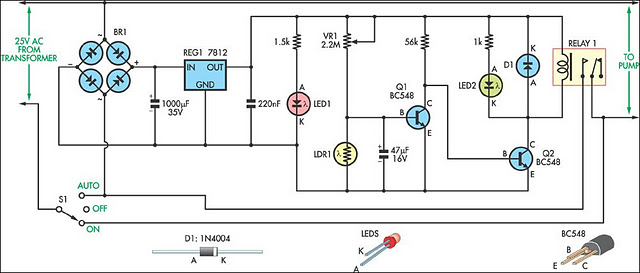Home » Circuits
Light-Controlled Pond Pump
This circuit was constructed to control the pump in a garden pond, so that it automatically turns on at dawn and off again at dusk. Not only does this mean that we don’t have to get cold and wet when turning the pump on or off manually but it’s also one less job for our kind neighbours when we go away on holidays! The controller is powered from the pump’s existing 25VAC mains transformer. A bridge rectifier (BR1) and 1000μ F capacitor provide DC power to the circuit. For dependable operation, this is regulated to +12V by a 7812 regulator (REG1), while a red LED (LED1) provides power-on indication. The light sensor (LDR1) is a Cadmium-Sulphide photocell obtained from Tandy Electronics. The photocell forms a voltage divider with trimpot VR1.Circuit diagram:
With no light on the photocell, the voltage on the base of Q1 is greater than 0.6V and therefore it is switched on. When light falls on the photocell, its resistance decreases, lowering the bias voltage on Q1 and switching it off. This in turn allows Q2 to switch on, energised the relay and turning on the pond pump. In use, the 2.2MΩ trimpot is adjusted so that the pump cuts out at the desired light level. A 47μ F capacitor across LDR1 prevents transient light changes from affecting circuit operation. S1 is a miniature SPDT centre-off toggle switch, allowing the pump to be turned on or off manually, or switched to automatic mode. The circuit was constructed on a small protoboard from Dick Smith Electronics (Cat. H 5604) and housed in a bulkhead box, which was then attached to the transformer housing. The photocell was soldered to a length of figure-8 cable and sheathed in a short length of heatshrink tubing to form a light probe. This was attached to a nearby fence post to provide suitable exposure to sunlight.
Author: Ian Hogan - Copyright: Silicon Chip Electronics

